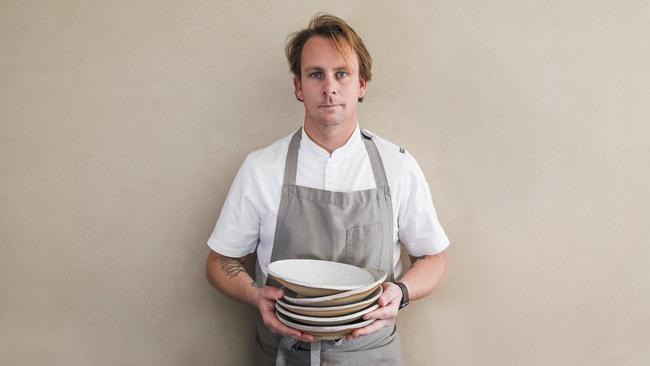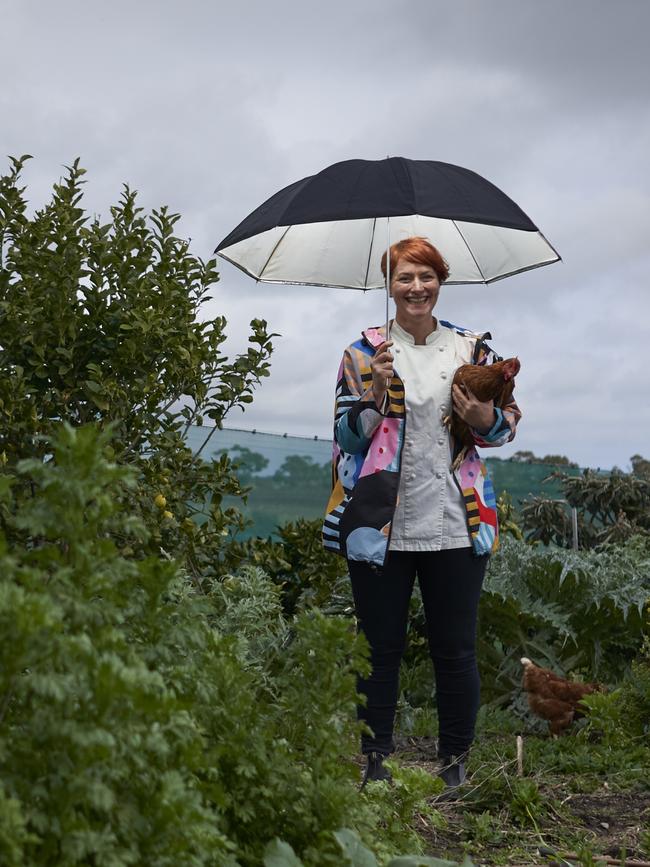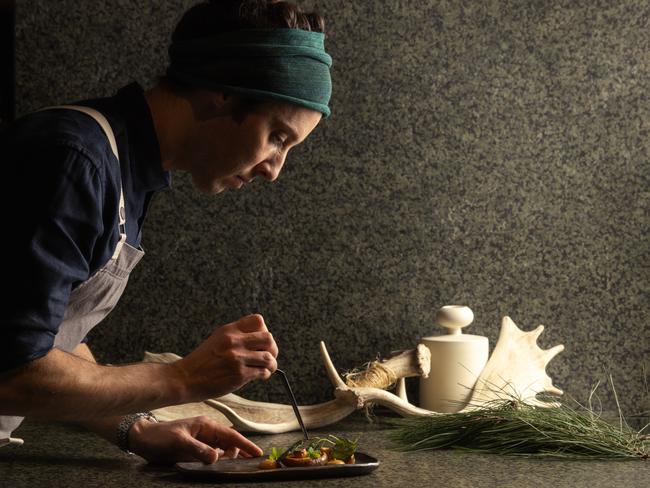Watch your waste line
As more chefs embrace sustainability, diners can help persuade other restaurants to go green too.

The internet can be an unforgiving place; there are things out there so many of us would rather simply disappear.
Like, perhaps, superstar New York chef Daniel Humm’s signature duck with plum and daikon from 11 Madison Park, once rated the “best” restaurant in the world, in 2017, and quite possibly the most expensive too. Part of a now-defunct multi-course tasting menu, a whole duck is roasted simply to produce four plates, each with half a bird’s breast sliced lengthways. That’s it.
As an example of three Michelin star excess, it emphasises a kind of obscenity of Old World thinking in the kitchen that’s rapidly disappearing. And tellingly, 11MP went completely vegan in May this year with a 12-course, $US335 (pre-tip) per head, duck-free menu.
It’s booked solid for months.
From the aspirational world of haute cuisine of 30 years ago to the poster kids of zero-waste and minimal environmental footprint, such as London’s Silo and the restaurant’s waste evangelist chef Douglas McMaster, there has been a generational change in what represents “the right way to do things” in restaurants around the world.
Top-end kitchens – once homes of unconscionable food waste in order to present the perfect bit of an animal or vegetable, like five centimetres of asparagus tip or merely the heart of a cos lettuce, mountains of plastic used for storage and delivery and waste management, and a devil-may-care attitude to food miles and seasonality of ingredients – are increasingly places where impact on the planet plays a significant part in the thinking.
The era of Australian chefs heavily influenced by the likes of Michel Roux, Marco Pierre White, Thomas Keller and Raymond Blanc (gods of their time?) is rapidly fading. The men and women running restaurant kitchens in Australia today are as much interested in using by-catch and retired dairy cattle for protein as they are in the perfect ballottine of farmed duck.
And so it may be that the lasting legacy of the bellwether chefs of today’s cooking world, your Massimo Botturas, Rene Redzepis, Douglas McMasters and Dan Barbers, is not so much in the dishes we eat when we go out, but in the way our chefs think about waste. Sustainability. Environmental impact.
These parameters increasingly provide a framework for the creativity of our best chefs.
And it’s a classic chicken/egg equation. Are we driving them, or vice versa? In some cases, it’s very clear that it’s the chefs who are taking the lead.
So what should we as consumers take for granted in our great restaurants from a sustainability, environmental practice and good kitchen management perspective?
Seasonality, obviously. Locally sourced produce should be a given. Minimum wastage of precious resources, putting every part of the animal, and vegetable, to good use is just good business sense, surely?
Unfortunately, too many restaurants make a song and dance about doing the sort of things that a restaurant really should be doing anyway. Like buying a whole duck and using every part of it for a variety of dishes. Or establishing relationships direct with growers.
It’s not rocket science. And these are certainly restaurants that are deserving of your support.
But some take it further; for some, it’s not about greenwashing but rather a deep commitment to softening the environmental impact of a commercial food operation that just happens to operate at the high end of the restaurant business.
It’s about a deeper nexus between farmer and cook than has been the norm in times past; chefs who not only acknowledge the impact of particular farming practices but who seek to nurture change in both their consumption habits and the role of educator they take on.
The usual suspects when it comes to walking the green walk in the Australian kitchen context include Melbourne chefs Matt Stone and his partner Jo Barrett (late of Oakridge, now Future Food Systems); their mentor – restaurateur and green entrepreneur – Joost Bakker; and Sydney fish chef Josh Niland. All have been profoundly influential.
In the UK, it’s a chef who once worked at Bakker’s Melbourne zero-waste cafe Silo – Douglas McMaster – who has literally written the book on zero waste restaurants, first in Brighton and now Shoreditch. Silo, The Zero Waste Blueprint is a manifesto for chefs and restaurateurs who want to change the way they operate. He says, among other things, that while in an average restaurant up to 50 per cent of all food goes to waste, in a fine-dining restaurant that figure is closer to 80 per cent. It’s an educated guess but it highlights that top-end restaurants are among the worst offenders.
Responding to the growing emphasis on these factors to both consumers and hospitality, a group including Adelaide chef Duncan Welgemoed, of Africola restaurant, this year set out to build a new awards program, Eat Easy, that puts sustainability and environmental concerns front and centre.
Entrants to Eat Easy were asked to demonstrate efforts across a broad list of criteria, from produce sourcing to waste minimisation and on to community engagement.
“The more you look at the practises we’ve all be using over the past few decades, the more concerning the impacts of restaurants become, especially when you extrapolate it out to the number of businesses out there,” says Ben Devlin.
A chef who runs the acclaimed Pipit restaurant in Pottsville in northern NSW, Devlin was one of the standout Eat Easy entrants. In almost textbook fashion, Devlin attributes much of his thinking to a formative job at Noma in Copenhagen, and working closely with owner Rene Redzepi in the early days of what has become the world’s most influential restaurant.
“Developments in areas like packaging and convenience items for restaurants have had huge benefits (but have) often been widely taken up without much thought to the potential environmental costs,” he says.
“Plastic wrap and vacuum bags, for example, are tremendously useful, but the amount of single-use plastic going into landfill every day from restaurants … is kind of terrifying.
“And once you start to think more critically about the systems you’ve been working in, you start to often see huge wastefulness that is really only in the interest of small, short-term savings.”
At Pipit, for example, there is no cling film used; no vacuum bags; cooking in a water bath is done using beeswax rather than plastic.
If there is a biodegradable or reusable option – piping bags, for example – that’s what happens. Suppliers are required to deliver only in reusable containers. And the restaurant’s crockery, handmade by local ceramicist Grit, uses the restaurant’s waste fish bones, mollusc shells and grill ash in its clay mixes.
“A lot of things you find yourself doing mostly because you believe it’s the right thing to do or you are trying to make something unique,” says Devlin, who puts a particular emphasis on sustainably harvested seafood and serves no red meat.
“I’d say most (restaurant) businesses are thinking about sustainability in some fashion, (but) it ends up being a question of which fight do you really want to pick?
“We are definitely strict with some of the things we choose to serve and practises we follow, and as a small business owner/operator I have the ability to make the choices that I personally believe benefit our guests and our community … but I know that I can’t expect every business to make those decisions.”
Karena Armstrong is another who puts her restaurant business into a far greener context than most. Behind the scenes at The Salopian Inn, in rural McLaren Vale, Armstrong says her industry can make a huge difference to the way food production, consumption and packaging is viewed.
“We have to change,” she says.

“This culture of endless hedonistic consumption without responsibility is damaging our environment. Food is so central to who we are as a community, serving it to customers shouldn’t come at the cost of environmental damage to that same community.”
And how do her customers benefit from practices behind the scenes, in most cases things they are completely unaware of?
“We talk a lot about our kitchen garden,” she says, “our bees, composting, low food miles and local producers. But the way we recycle, use solar and green power, are moving to less paper use and shred our menus to keep our chickens’ bottoms warm we don’t talk about so much. Maybe we should.”
Equally, she says, there’s an important role educating and sharing her ideas with peers.
“When new chefs walk into my kitchen we always have to do some re-training. Teaching chefs how to use what they’ve been taught is waste, turning it into something delicious, takes changing a mindset. Composting and growing food is a new concept to so many … but ultimately, good chefs connect with the natural world; they want to respect the environment.”
Kane Pollard’s approach to a better world is an almost fanatical obsession with use, re-use and exploiting by-product.

At his humble yet impressive Topiary Cafe on the outskirts of Adelaide, and at Sol in the CBD, where he is employed as head chef, Pollard uses every part of every bird, fish or animal. He has quite literally turned waste into art with dishes like Peasant’s Bisque (using all the fish offcuts), Skin and Bone Borsch (using excess skin and bones from various animals with beetroot), Whole Pork Pie (crackling shortcrust, head and shoulder rillettes, belly and cheek ham), Condensed Whey Panna Cotta (reducing his house-made cheese whey to a syrup), Whole Corn Custard (using the cob, kernels and husk from the corn), Beet Leaf Salsa Verde (using beetroot, radish and carrot tops), Roast Pumpkin Cake and Pumpkin Skin Treacle, as well as various sauces and condiments using trimmings and offal.
“It’s time for everybody to stand up and make a change,” says Pollard. “But if the people who are so passionate about food that it’s their livelihood aren’t getting the ball rolling, then who will?”
Unfortunately, he says, there’s no bottom-line benefit whatsoever to doing things the hard way.
“Food cost percentages may drop a little, but the amount of labour it takes to break down, wash, pick and process every item on the menu well and truly outweighs it.
“If we ordered in the exact cut of meat we needed, or the glasshouse-grown, graded vegetables that look perfect on the plate each week, then the reality is that some of my most passionate chefs would no longer have a job. Nor would they want to work with me anymore, either.
“And in those moments when I’m not sure which direction to take, I always ask myself, ‘What would they have done 100 years ago when the world was a much healthier place?’ ”
Being in a remote location, where suppliers need to be managed carefully, Brendan Pratt in Margaret River takes some fairly innovative ideas to the concept of utilising as much of his raw produce as possible.

In the Vasse Felix kitchen, Pratt takes whole eels, for example, using the flesh to make a sauce and the skin, bones and head to make a garum, or fish sauce, which he uses to season dashi.
With whole Patagonian Toothfish, caught in the sub-Antarctic by Perth seafood company Austral, Pratt dry-ages, and then smokes the frames before breaking them down to cook with Japanese ingredients to make a tare, or dipping sauce. Beef fat, rather than being discarded, is used to make various butters and sauces.
“Quite often this process opens our minds up to new ideas of luxury,” Pratt says, “as well as adding more incredible flavours and textural elements to our dishes.
“Often the so-called ‘waste’ from preparation of one dish feeds into another.”
Restaurant customers, he says, need to ask more questions about where and how what they are eating has been sourced, prepared and treated.
“Knowledge is power,” he says. “And if more customers demanded better and were understanding of the costs to a business to exercise an environmental conscience, we might be able to effect change a lot faster.”
John Lethlean was one of 15 Eat Easy Awards judges.

To join the conversation, please log in. Don't have an account? Register
Join the conversation, you are commenting as Logout